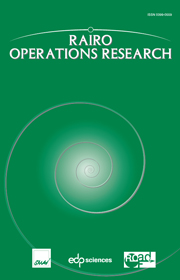No CrossRef data available.
Article contents
Interactive compromise hypersphere method and its applications
Published online by Cambridge University Press: 26 September 2012
Abstract
The paper focuses on multi-criteria problems. It presents the interactive compromise hypersphere method with sensitivity analysis as a decision tool in multi-objective programming problems. The method is based on finding a hypersphere (in the criteria space) which is closest to the set of chosen nondominated solutions. The proposed modifications of the compromise hypersphere method are based on using various metrics and analyzing their influence on the original method. Applications of the proposed method are presented in four multi-criteria problems: the assignment problem, the knapsack problem, the project management problem and the manufacturing problem.
Keywords
- Type
- Research Article
- Information
- Copyright
- © EDP Sciences, ROADEF, SMAI, 2012


